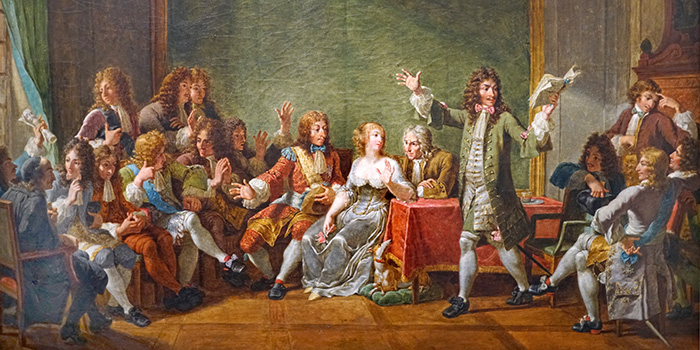Quiz Topic Sheet
The 17th Century in Literature
The 17th century in literature was a time of tension and creativity, marked by classical rigor, spiritual aspirations, social critique, and stylistic experimentation. Shaped by absolute monarchy, religious upheavals, and the early stirrings of Enlightenment thinking, this era produced major literary forms and works that continue to influence literary history.
Advertisement
Classical Theatre and Social Comedy
- Molière dominated the French stage with comedies like The Misanthrope, Tartuffe, The Pretentious Young Ladies, and The Imaginary Invalid, exposing hypocrisy and the flaws of his time.
- Pierre Corneille revolutionized tragedy with Le Cid (1637), followed by Horace and Cinna.
- Jean Racine embodied the height of classical tragedy with Phèdre, and retired from theatre after its failure.
- In England, William Shakespeare wrote his great tragedies in the early 17th century (Hamlet, Macbeth), remaining a central literary figure.
- Ben Jonson, Shakespeare’s rival, shaped English theatre with works like The Alchemist.
- Spanish playwright Lope de Vega, founder of the Comedia nueva, was one of the most prolific writers in history.
- Italian playwright Giambattista Guarini contributed to Baroque theatre with Il Pastor Fido, a pastoral tragicomedy.
Novels and Narrative Forms
- Miguel de Cervantes began Don Quixote while in prison, creating a foundational work of the modern novel.
- Madame de La Fayette shaped French literature with The Princess of Cleves (1678) and The Princess of Montpensier (1662).
- Paul Scarron explored burlesque fiction with The Comic Novel (1651–1657).
- Madeleine de Scudéry contributed to the rise of précieux novels with works like Clélie.
- Fénelon’s Telemachus (1699) was a pedagogical novel inspired by antiquity and critical of absolute power.
- Cyrano de Bergerac mixed satire and imagination in his Imaginary Voyages, published posthumously in 1655.
- Charles Perrault formalized the fairy tale genre with Tales of Mother Goose (1697), laying its literary foundations.
Moral Thought and Philosophy
- Blaise Pascal’s Pensées (1670), published after his death, reflected on faith, reason, and the human condition.
- François de La Rochefoucauld offered a sharp view of human nature in his Maxims (1665).
- Jean de La Bruyère criticized the morals of his time in The Characters (1688).
- René Descartes transformed philosophy with Discourse on the Method (1637) and his maxim “I think, therefore I am.”
- Thomas Hobbes, in Leviathan, defended the need for a strong sovereign to prevent chaos.
- Pierre Bayle’s Historical and Critical Dictionary (1697) paved the way for Enlightenment thought.
- Bernard de Fontenelle popularized science with Conversations on the Plurality of Worlds (1686).
Poetry, Fables, and Style
- Jean de La Fontaine published The Fables between 1668 and 1694, blending satire, morality, and entertainment.
- Nicolas Boileau codified classicism in The Art of Poetry (1674), promoting clarity, restraint, and imitation of the Ancients.
- The sonnet and alexandrine became favored poetic forms in this era of structured verse.
- Baroque poetry persisted at the century’s start, before being eclipsed by classical ideals.
Characters and Literary Figures
- Alceste, from The Misanthrope, represents the disillusioned idealist in conflict with society.
- Rodrigue, hero of Le Cid, is torn between love and honor.
- Hamlet, Shakespeare’s prince, embodies existential doubt and reflection.
- Phèdre, in Racine’s tragedy, is destroyed by forbidden passion.
- Telemachus, in Fénelon’s novel, symbolizes the enlightened prince seeking virtue.
- Don Quixote, both tragic and comic, pursues a misguided ideal in a pragmatic world.
Memoirs and Testimony
- Saint-Simon, in his posthumously published Memoirs, provides a sharp chronicle of Louis XIV’s court.
- Donneau de Visé, with Le Mercure galant (from 1672), mixed news, society reports, and satire.
- Europe-America Relations and Historical Context
- The century was marked by colonial expansion, religious missions, and power struggles.
- Religious and political censorship shaped literary dissemination, pushing some authors to publish anonymously or posthumously.
- Literature and power were closely intertwined: whether praising, advising, or criticizing rulers, writers played a key role in Ancien Régime society.
Advertisement
Quiz questions preview
-
He is a character from Molière's play "The Misanthrope" (1666).
Sganarelle | Alceste | Dom Juan | Géronte -
Who popularized the "precious" novel with *Polexandre*, published between 1632 and 1637?
Marin le Roy de Gomberville | Paul Scarron | Honoré d’Urfé | Madeleine de Scudéry -
Which moralist published *Maxims* in 1665, a collection of aphorisms analyzing human behavior?
Blaise Pascal | Jean de La Bruyère | Marquis de Vauvenargues | François de La Rochefoucauld -
Which writer authored “Télémaque” in 1699, a novel inspired by Antiquity depicting the ideal of good governance?
François Fénelon | Molière | Jean Racine | Paul Scarron -
In prison in 1604, this writer began «Don Quixote», a foundational masterpiece of the modern novel.
Francisco de Quevedo | Miguel de Cervantes | Lope de Vega | Fernando de Rojas


